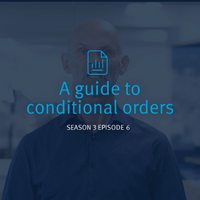A guide to conditional FX orders
27-12-2022 | treasuryXL | Kantox | LinkedIn |
In this article, we look closely at conditional FX orders, a powerful tool when executing your hedging strategy, and the unique role it plays in currency management — especially when it comes to delaying the execution of hedges.
Conditional orders: a brief definition
A conditional FX order is an order to execute a spot or a forward transaction to buy or sell one currency against another—but only when a predetermined limit is reached.
Conditional orders include stop-loss (SL) and take-profit (TP) orders. While SL orders are aimed at avoiding losses beyond a certain limit, PT orders are designed to take advantage of favourable moves in currency markets.
Note two time-related aspects of conditional orders in forward markets:
(a) The tenor of the underlying forward contract is specified (it could be one month, six months, or a year)
(b) The validity of the order is specified too (it can be valid for two weeks, six months, or set on a good-until-cancelled basis).
Conditional orders are usually set on an OCO basis: one-cancels-the-other, automatically to avoid the same exposure being hedged twice in the event of extraordinary market volatility.
Note, too, that in the event of extraordinary market volatility, conditional orders can be executed at less favourable levels than desired. This limitation exists not only in FX but in all financial markets.
A powerful tool for risk managers
The primary purpose of conditional orders is to provide a safety net around an FX rate that the treasury team wishes to defend.
It can be the rate used in setting prices —aka the campaign/budget rate—or a ‘worst case scenario’ FX rate.
Say that you wish to defend the rate of EUR-USD = 1 on a spot basis while the market is trading at 1.08. In this case, it is prudent to set three SL orders, each covering a third of the exposure, at 1.02, 1.00 and 0.98, respectively.
Assuming that the three levels are hit, you are mathematically assured to defend your budget or worst-case scenario FX rate.
Time is on your side
In hedging programs designed to protect a budget FX rate, the ‘buffer’ set between the market rate towards the start of the campaign and the rate to be defended with SL orders provides risk managers with a critical resource: time.
As long as the SL orders are not executed, the passing of time means that hedge execution is delayed while FX risk remains fully under control. This brings the following four systematic advantages:
(a) More time to update cash flow forecasts
(b) More savings in terms of the cost of carry when forward points are unfavourable
(c) No cash immediately needed for collateral requirements
(d) More netting opportunities
And it’s not over yet! With luck, your TP conditional orders can be hit as well.
Backtesting conditional orders
We recently conducted a backtest of a hedging program designed to protect the budget rate of a UK-based exporter selling into emerging markets. Over a four-year period (2017-2020), the firm would have outperformed its budget rate in three of those years while equalling it in the remaining year. In one year alone, overperformance reached 5.8%.
Delaying hedge execution with risk under control allowed the treasury team to hedge on the back of firm commitments, providing a better hedge rate than the stop-loss orders. So there you have it: when managing currency risk, consider using conditional orders. Time will be on your side. And you’ll sleep well at night!
P.S. If you’re drafting your upcoming budget, download our Budget Hedging report and find out how to use conditional orders.











